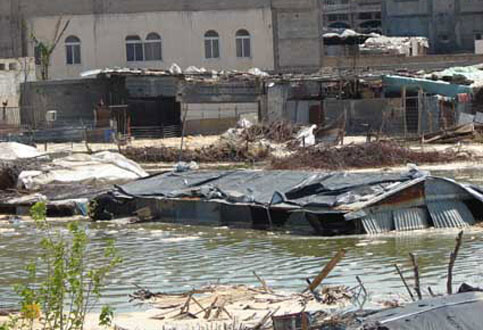UN Office for the Coordination of Humanitarian Affairs 28 March 2007

NEW YORK — United Nations relief agencies are responding to the needs arising from the bursting of a sewage reservoir in an emergency filtration basin at the waste water treatment plant in Beit Lahia in Gaza.
According to latest reports, waste flooding into the nearby Bedouin village of Um Al Nasser killed four people and injured 18, while 11 people remain missing. Ninety-six homes were destroyed or damaged. Between 250 and 300 families have been relocated to a temporary camp situated on higher ground between the Bedouin village and the former Israeli Nissanit settlement.
Preliminary needs assessments indicate that tents, blankets, mattresses, food and water are required for those who have moved to the new camp. Concerns also exist over the possible spread of communicable diseases in the absence of basic sanitation facilities, and due to the prevalence of sewage-infiltrated households.
The United Nations Relief and Works Agency for Palestine Refugees in the Near East (UNRWA) has sent 300 tents and six water tanks, as well as blankets and mattresses to nearby Jabalia. Other United Nations agencies and non-governmental organizations (NGOs) have also identified supplies that can be used in the response.
Additionally, the joint United Nations Environment Programme (UNEP)/Office for the Coordination of Humanitarian Affairs (OCHA) Environment Unit is on stand-by to provide any further specialised assistance as needed. A request for international assistance was yesterday transmitted from the Palestinian Environmental Quality Authority to UNEP.
Built in 1976, the Beit Lahia waste water treatment plant was originally designed to serve up to 50,000 habitants in Gaza. However, the total population of the area served by the plant is now over 200,000 and continues to rise. The combination of an ever-increasing volume of waste and insufficient capacity has led to effluence overflowing from filtration basins into the surrounding sand dunes, creating a small lake that now covers over 110 acres; in 1995, the affected area was 13 acres. Previous flooding on a lesser scale occurred in 1989 and 1992.
In response to the Palestinian Water Authority (PWA)’s rising concern over the expansion of the lake, an emergency filtration basin was completed in September 2006 in order to add additional capacity to the existing seven basins. Additionally, the western side of the main effluent lake at the waste water treatment plant is believed to be weak and could be close to collapse if not reinforced immediately. A further 800 houses could be affected in the event of additional flooding.
More Information
Related Links